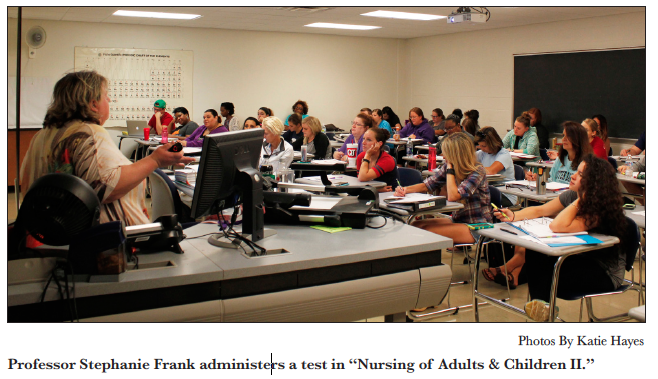Dual Admission Program makes for a smooth transition
A Dual Admission Program between the STLCC nursing program and Webster University was approved in May 2015 by the board of trustees. Students who are admitted into the Dual Admission Program have also been accepted into the Nursing Program at Webster University.
The Webster Dual Admission Program was developed by Jennifer Broeder, associate dean of professional programs at Webster University, Vincent Featherson, dean of allied health, natural sciences and physical education at STLCC and Karen Mayes, director of nursing education at STLCC. Students in the Dual Admission Program can begin taking courses at Webster University as early as summer 2016.
“Several of us met with Webster University representatives and decided on what [credits] they would accept from us, which is everything, and what additional courses our students would need to take to complete a bachelor’s,” Mayes said.
There is already a Dual Admission Program with University of Missouri-St. Louis, but many other area universities want to implement this program as well.
“Across the country over the last five years, there has been a huge push to not only hire BSN nurses, but to make the progression from ADN to BSN more available,” Mayes said.
A lot of hospitals want students who are BSN prepared as entry level and students graduating with their associate’s were having trouble finding jobs, STLCC Nursing Professor Stephanie Franks said. Originally, the bachelor’s level was supposed to be for management and higher level supervising but is now more so an entry level for nurses. Students in the Dual Admission Program can tell employers they are pursuing a four-year degree before they have even started classes at Webster. This gives students more options as to where they can find employment.
“It makes our students more marketable, because right now some hospitals are starting to give an advantage to graduates that have a bachelor’s degree. So if our students are able to say, ‘but look, I have already started a bachelor’s program’ that is a huge plus,” Mayes said.
A bachelor’s degree is financially feasible for STLCC students who are transferring to a four-year university. In addition to Webster University waiving the application fee and scholarships available for transfer students, many employers will also pay for students to earn their BSN.
“All of the area hospitals that I’m aware of will offer tuition reimbursement for their employees,” Mayes said. “That’s another way ADN grads can benefit, because they can be out working, and then their employer will pay for their degree.”
There are more advantages to students beginning their academic career at STLCC than the financial, however.
“We’re a two-year program here, so we get students in the hospital that first semester,” Franks said. “With a bachelor’s program, there is more theory behind it. So [four-year universities] are teaching [students] a lot of the theories, like the theory of nursing or the theory of patient care. So students sometimes don’t start until their junior year in the hospitals. So I feel that the associate’s degree nurse is more ready for that bedside job than the bachelor’s degree nurse.”
The entire nursing program is designed to take four years.
This means that students have four years of just nursing classes, which does not include the prerequisites to be admitted into the program. “You just can’t avoid putting in the time to learn everything you need to learn, so you can safely care for patients,” Mayes said. Admission into the nursing program is selective and determined by a waitlist.
Selective admission to the nursing program means students have to have the chemistry, the biology, the 2.5 GPA and pass the dosage calculation test, Mayes said.
“Our belief is first-come, first-serve. As soon as you have met those prerequisites, you go on the waiting list,” Mayes said. “Being a community college, we firmly believe that we have the philosophy to give everyone a chance.”











